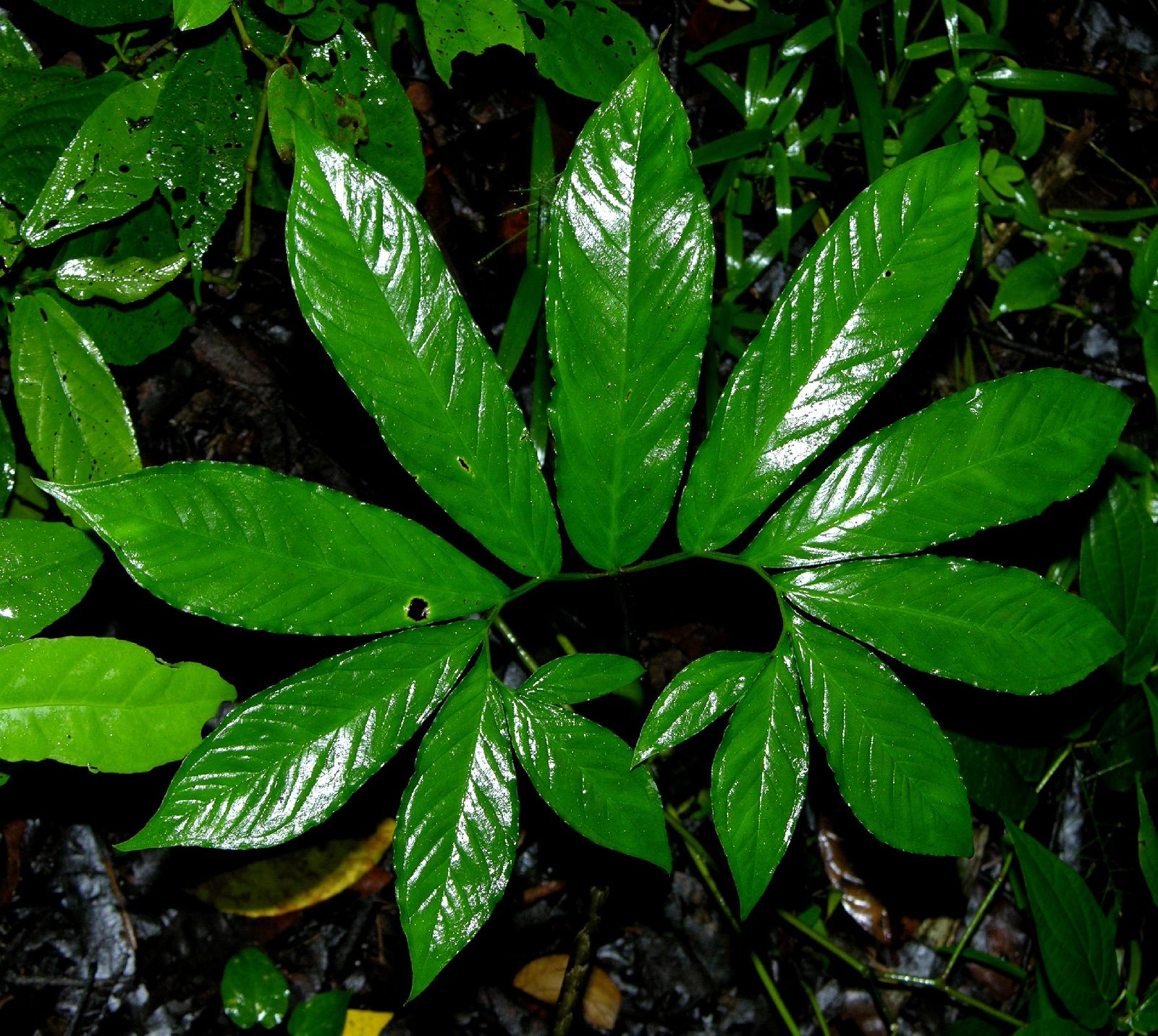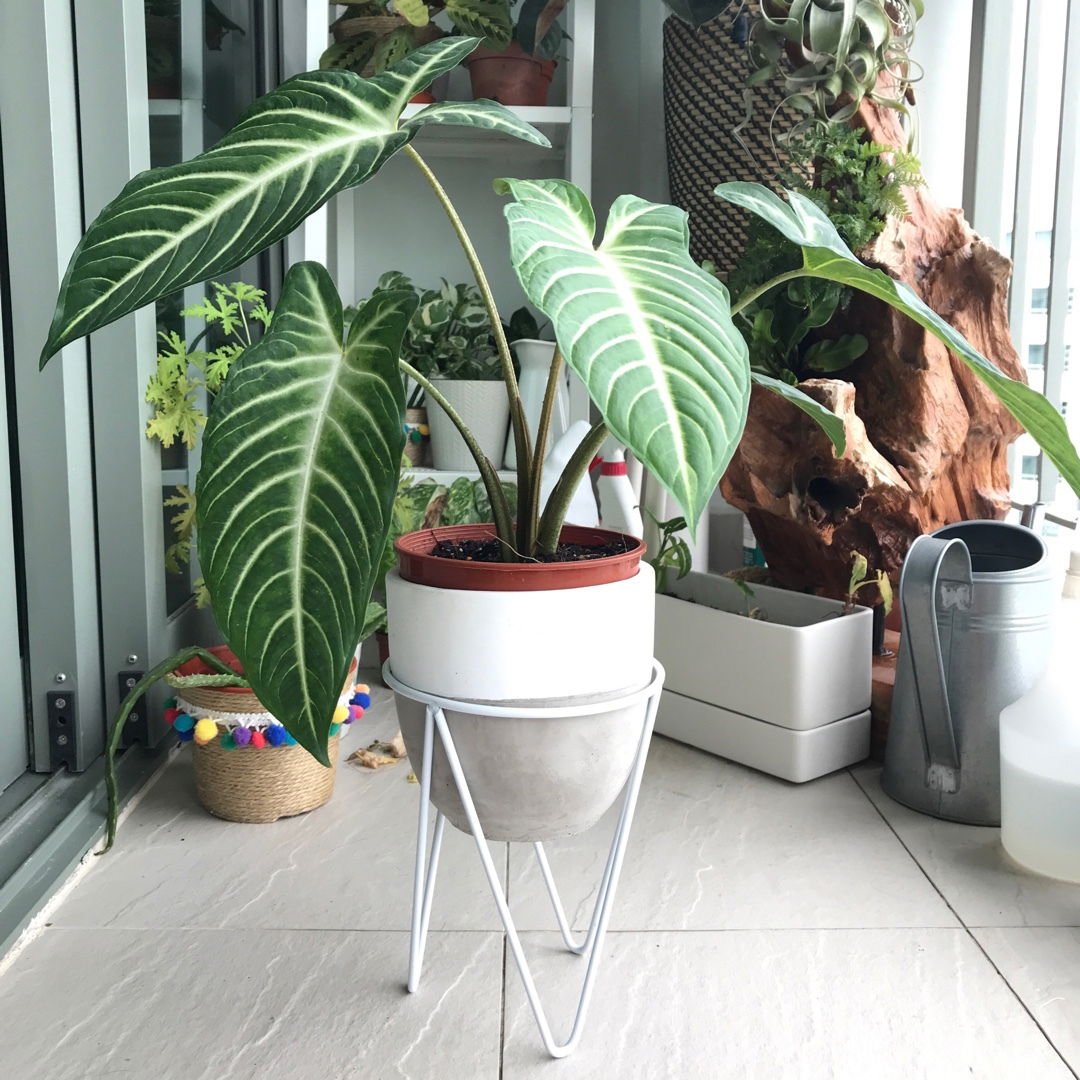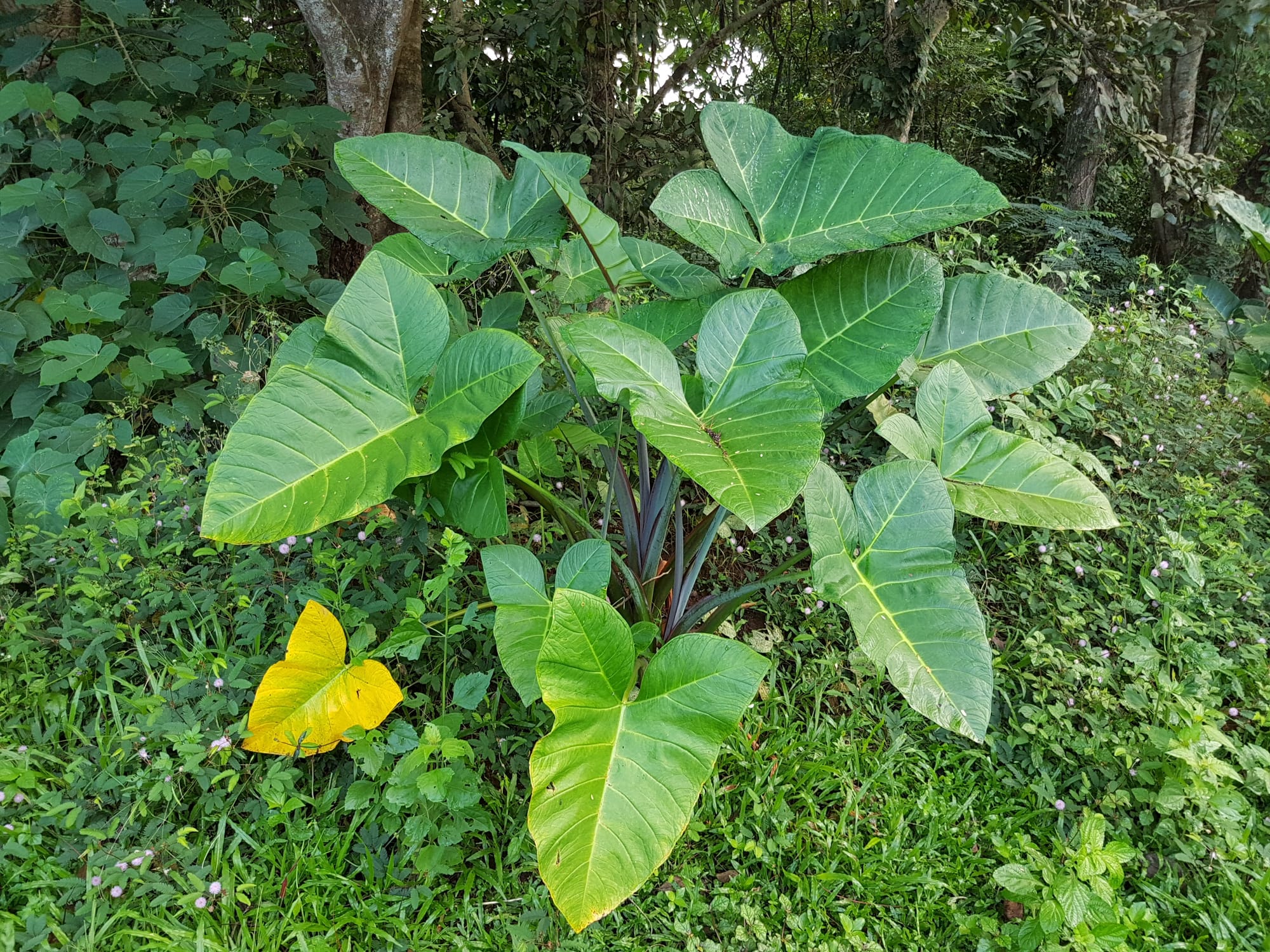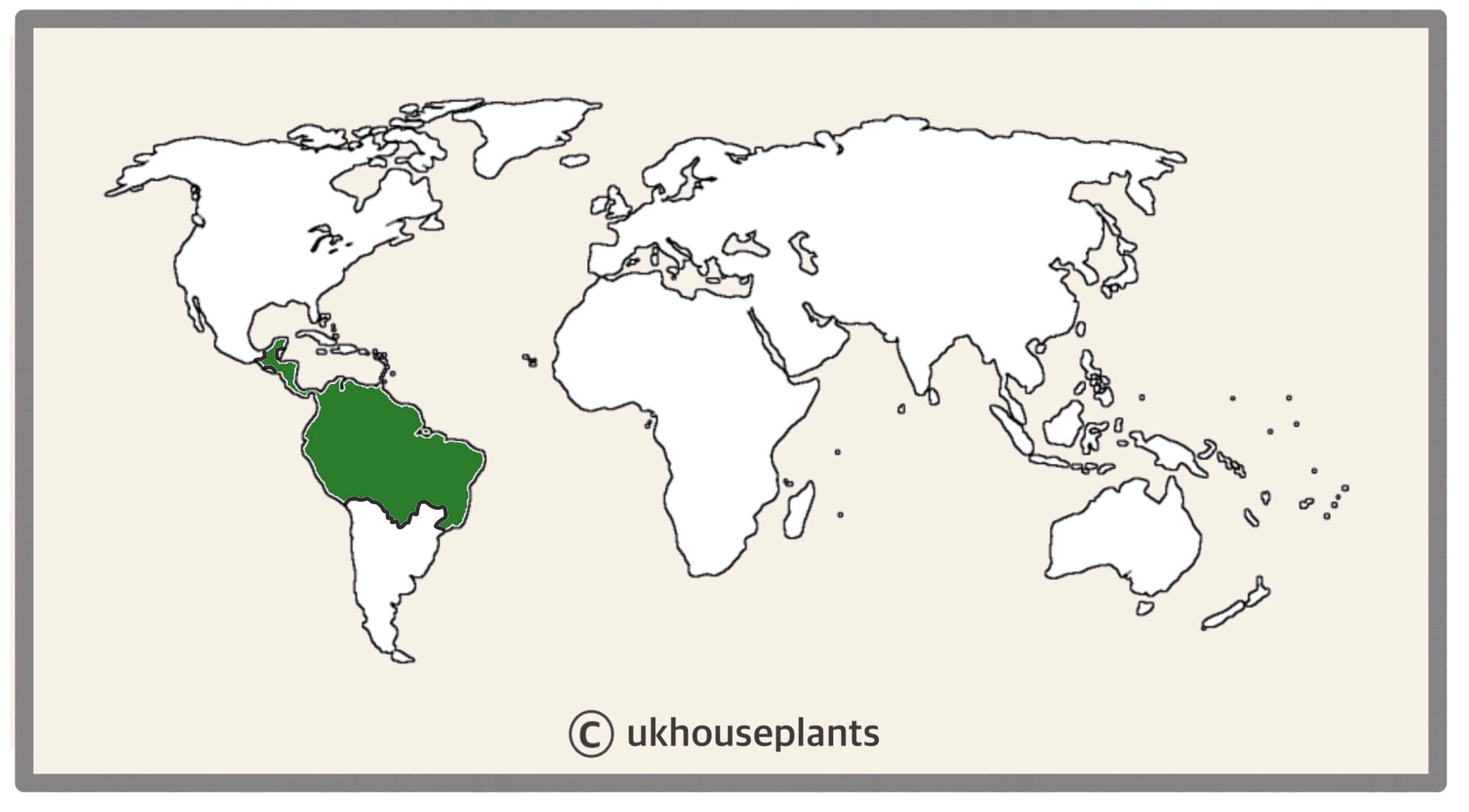
Xanthosoma helliborifolium. Copyright: CoTRAM
Contents
- Top Tips
- Location, Water, Humidity & Fertilisation
- Common Issues
- Origins, Temperature, Propagation, Repotting & Toxicity.
Need the answer to a specific plant query? Book a 1-to-1 video call with THE HOUSEPLANT DOCTOR™, the website's friendly author, to overcome and address your niggling problem! Available on iMessage, WhatsApp, Facebook Messenger & more.
Top Tips & Info
- Care Difficulty - Easy
- Xanthosoma grow best in spots that can provide near-perfect overhead lighting; within 2m of a window or in a semi-shaded conservatory are best for its overall health.
- Allow the top third to dry out in between waters, reducing this further in the autumn and winter; over-watering is the most common issue with Xanthosoma, so always be cautious with your regime.
- Fertilise using a 'Houseplant' labelled feed every four waters in the spring and summer, reducing this to every six in the colder months.
- Keep an eye out for Spider Mites that'll form webs on the under-leaves of the plant, Aphids that'll attack the juvenile growth.
- Especially with those kept in a dark location, gently rinse the foliage monthly to increase the light-capturing efficiency.
- Repot every three years using a 'Houseplant' potting mix, or a general-purpose compost with some perlite. Introduce some grit for larger specimens to strengthen their root system.
Location & Light - 🔸🔸
Bright overhead lighting is best for wholesome (360º) growth, as locations too far from the window will cause dramatic phototropism. Although the excessive sunlight should be avoided at all costs, an hour or two of winter sun will provide vital nourishment to get it through the dormancy period.
Xanthosoma can be trained to tolerate harsher levels of sunlight (with exceptions) than most houseplants, by gently increasing the number of hours in the sun over the oncoming month. This process is best done from autumn to late winter, whilst the rays are at their weakest.
Each week, increase the amount of light by an hour, starting with just an hour of morning sunlight to gain its momentum. The plant will slowly decease the production of chlorophyll, which in turn will reduce the risk of bleaching and sun-scorch. Remember to keep the specimen well hydrated during this period, and always abort the experiment if it shows signs of sun-scorch. The maximum amount of sunlight for this plant is around four hours a day.
Water - 🔸🔸
A key difference between the Xanthosoma and its famous counterpart, Alocasia, is the tendency of needing slightly more water. Although it's highly important to not fall in the trap of over-watering (especially with those located in darker environments), periods of drought will result in the specimen falling back into its dormancy with stunted growth. Allow the top third to dry out in between waters, reducing this further in the autumn and winter. Under-watering symptoms include stunted growth, brown leaf edges and yellowing leaves. These issues are commonly caused by being pot bound, too much sunlight or heat, or pure forgetfulness. Over-watering symptoms include a collapsed base, yellowing older leaves, mouldy soil and plant death. If you feel that root rot is to blame, remove the affected leaves, roots, and soil, and replace with a fresh batch of houseplant compost. Click on this link for more info about addressing this disease.
Humidity - 🔸🔸
Create a humidity tray while the heaters are operating to provide a moist and stable environment for your plant. If the surrounding saturation is too low or the heat too high, its leaf-tips may start to brown over and curl, especially in direct sunlight. Hose the foliage down from time to time to hydrate the leaves and keep the dust levels down.
Fertilisation - 🔸🔸
Feed every four waters during the growing period and every six in the autumn and winter, using a 'Houseplant' labelled fertiliser. Never apply a 'Ready to Use’ product into the soil without a pre-water first, as it may burn the roots and lead to yellowed leaves.
 Xanthosoma lindenii. Copyright: GardenTags
Xanthosoma lindenii. Copyright: GardenTags
Common Issues with Xanthosoma
Older leaves that rapidly become yellow are a clear sign of over-watering, usually caused by too little light, with other symptoms include mouldy or heavy soil, stunted growth and a rotten base. Although Xanthosoma can be placed in darker locations, the frequency of irrigations must be reduced to counteract the chance of root rot. People don't realise that a plant's root system needs access to oxygen too; when soil is watered, the air will travel upwards and out of the potting mix. A lack of accessible oxygen will cause them to subsequently breakdown over the oncoming days. Click on this link to learn more about root rot and how to address it.
Curled leaves and brown leaf-edges are the result of too little water and over-exposure to the sun. Xanthosoma are best located in bright, indirect settings, and those that haven't acclimatised to the harsh rays will show signs of sun-scorch and environmental shock. A splash of winter sunlight is acceptable as long as the soil moisture is regularly observed, with complete avoidance once summer comes along.
Due to the species' sensitivity to chemicals, Leaf Shine shouldn't be used to improve the appearance of the foliage, and instead should be cleaned via a rinse of lukewarm water. Failure to do so may cause yellowed, mottled spots that cannot be undone.
Yellowing sections along its leaves could be the product of many issues, ranging from spider mite to chemical burns. Think about its recent cultivation of how frequently you rehydrate its soil, along with a quick scan over the foliage's undersides. The use of 'Leaf Shine' or other chemical-based products may also have a detrimental effect on its health, as Xanthosoma are particularly sensitive to inorganic substances. When removing the affected leaf or leaves, be sure to avoid puncturing the yellowed/browned tissue as it may lead to further decline. Prune the entire leaf off via the petiole and investigate the rest of the plant for a potential spread of the problem.
 Alocasia can be riddled with pests due to its thin, broad leaves. In the image above, there's a third point of interest to look at - mineral/calcium deposits. This is a natural part of an Alocasia leaf's lifecycle, so don't worry about removing them!
Alocasia can be riddled with pests due to its thin, broad leaves. In the image above, there's a third point of interest to look at - mineral/calcium deposits. This is a natural part of an Alocasia leaf's lifecycle, so don't worry about removing them!
Clean the leaves regularly. Although this isn't too much of an issue, a build-up of dust particles can clog up the plant's pores, causing lowered light capturing-efficiency. Rinse the topsides of the leaves down once a month to keep levels down and improve growing conditions.
Too low humidity can cause browning tips with yellow halos on juvenile leaves. Although this won't kill your specimen, you may want to increase the local moisture to prevent the new growth from adopting these symptoms. Mist or rinse the foliage from time to time and create a humidity tray while the heaters are active to create a stable environment. The browning of leaf-tips on older leaves is wholly natural and is the product of extensive photosynthesis during its life.
Mould developing on the soil means two things - too little light and over-watering. Despite the harmlessness of the mould, it'll prove unsightly to most gardeners and is therefore removed once known. To remove, replace the top two inches of the soil for a fresh batch of 'Houseplant' labelled compost. Either increase the amount of light received (no direct sunlight for the first few weeks to prevent environmental shock) or decrease the frequency of waters slightly. If the mould is accompanied by yellowing lower leaves, you may also have a case of root rot.
 Xanthosoma sagittifolium
Xanthosoma sagittifolium
Origins
Xanthosoma was first described by Wilhelm Heinrich Schott in the 1830s, who used the Greek words xanthos & σῶμα, that translates to 'yellow body', referring to the colour of its stigma. It has a natural distribution across central to South America, from Mexico to Brazil!
 The Distribution of Xanthosoma.
The Distribution of Xanthosoma.
Temperature
10° - 30°C (50° - 86°F)
H1b (Hardiness Zone 12) - Can be grown outdoors during the summer in a sheltered location with temperatures above 12℃ (54℉), but is fine to remain indoors, too. If you decide to bring this plant outdoors, don't allow it to endure any direct sunlight as it may result in sun-scorch and dehydration. Regularly keep an eye out for pests, especially when re-introducing it back indoors.
Spread
Most species won't grow above 2m in height (if grown in a pot) and 1.5m in width; however, some larger specimens (Colocasia sagittifolium) can easily surpass this target. The ultimate height will take between 5 - 10 years to achieve, with up to six new leaves developed per season.
Pruning & Maintenance
Remove yellow or dying leaves, and plant debris to encourage better-growing conditions. While pruning, always use clean utensils or shears to reduce the chance of bacterial and fungal diseases. Never cut through yellowed tissue as this may cause further damage in the likes of diseases or bacterial infections. Remember to make clean incisions as too-damaged wounds may shock the plant, causing weakened growth and a decline in health.
Propagation
Via Seed or Corm Propagation
Corms (Easy to Moderate) - Most Alocasia are have corms, which are small globular-shaped bulbs that'll grow along the root system. A mature Alocasia can produce over twenty corms in its lifetime and can be harvested when you next repot it. Here's how to do it;
- The best time to repot is during the spring or early summer. Make sure that a few hours before repotting, you water the plant's soil to reduce the risk of 'transplant shock' when the roots are disturbed in dry soil.
- Take the mother plant out of its pot and gently work your fingers through the rootball (& soil) until you feel the small ball-shaped 1-2cm corms. Have a look at the image below for what they look like!
- With a clean pair of scissors or a knife, cut off the corm via the 'rhizome' that attaches it to the mother's root system. Make sure around 0.5cm+ of the 'rhizome' is still attached to the corm, so don't prune too close to the bulb itself. Have a look at the image below.
- Once separated, place the corm upright (see image below) and wholly in either soil or Sphagnum Moss. THE HOUSEPLANT DOCTOR™ recommends the moss as you can keep an eye out for root development or sudden issues of rot.
- With the mother plant, repot her back into the next sized pot with a fresh batch of either 'Houseplant' or 'Alocasia' labelled potting mix. If you're growing the mother Alocasia in hydroponics, repot this back into the same pot.
 Extra Tip: A healthy corm should be solid when pinched. Discard any bulbs that are softened or rotten as the bacteria will kill the whole corm.
Extra Tip: A healthy corm should be solid when pinched. Discard any bulbs that are softened or rotten as the bacteria will kill the whole corm.
 Here's a corm that THE HOUSEPLANT DOCTOR™ has grown hydroponically and is now ready to be planted in either soil or moss. (He recommends Sphagnum Moss as a good growing medium).
Here's a corm that THE HOUSEPLANT DOCTOR™ has grown hydroponically and is now ready to be planted in either soil or moss. (He recommends Sphagnum Moss as a good growing medium).
Flowers
Xanthosoma is part of the Araceae family, meaning that its flowers aren't particularly intriguing. Much like a Peace Lily's inflorescence, their flowers consist of a white or green spathe (the spoon-like shell) with the spadix being the site of pollination. Blooms can last up to five days and are usually visible during late spring or early summer around 40cm+ from the soil line. Unfortunately, domestic specimens will rarely flower indoors due to the insufficient growing conditions.
Repotting
Repot every three years in the spring, using a 'Houseplant' labelled compost and the next sized pot with adequate drainage. Hydrate the plant 24hrs before tinkering with the roots to prevent the risk of transplant shock. For those that are situated in a darker location, add a thin layer of small grit in the pot's base to improve drainage and downplay over-watering. Click here for a detailed step-by-step guide on transplantation, or via this link to learn about repotting with root rot.
Book a 1-to-1 video call with THE HOUSEPLANT DOCTOR™ if you'd like a personal guide to repotting your houseplant. This will include recommending the right branded-compost and pot size, followed by a live video call whilst you transplant the specimen for step-by-step guidance and answer any further questions!
Pests & Diseases
Keep an eye out for mealybugs, spider mites, scale, thrips & fungus gnats that'll locate themselves in the cubbyholes and undersides of the leaves. Common diseases associated with Xanthosoma are root rot, leaf-spot disease, botrytis, rust, powdery mildew & southern blight - click here to learn more about these issues.
Toxicity
This plant is classified as poisonous due to varying concentrations of calcium oxalate crystals found around the plant's body. If parts of the plants are eaten, vomiting, nausea and a loss of appetite could occur. Consumption of large quantities must be dealt with quickly; acquire medical assistance for further information.
Retail Locations
Xanthosoma specimens is rare in UK garden centres, but may be sold on mainstream websites throughout the year.
Book a 1-to-1 Call with THE HOUSEPLANT DOCTOR™
If you need further advice with your houseplants, book an advice call with ukhouseplants' friendly and expert writer today! This can be done via a video or audio call on most apps, including Facebook, FaceTime & Skype. A ten-minute call costs £5.99 (US$7), or £15.99 for thirty minutes. You can ask multiple questions, including queries on plants, pests, terrariums, repotting advice and anything in between. Please consider supporting this service to keep ukhouseplants thriving!